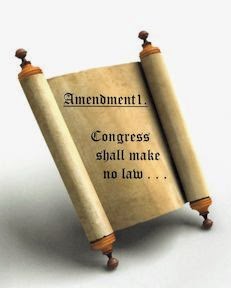Because most readers of
this blog are writers, some may have been on the staff of their school
newspapers. And those who were in high school or college after 1988 may be
aware of Hazelwood School District v.
Kuhlmeier, 484 U.S. 260 (1988).
In Hazelwood, the school principal pulled two articles from the
student newspaper before it went to press. One article talked about the
pregnancy experiences of three female students, and, although their names were
changed, the principal was concerned that enough details remained to make them
identifiable. He was also concerned that some of the discussion in the article
was inappropriate for younger students. The second article talked about divorce
and included a comment by a named student disparaging her father, who had not
been given the opportunity to respond. Since the school year was nearing its
close, the principal didn’t believe there was time to remedy the problems with
either article. As a result, he simply pulled them.
The Supreme Court ruled
that the principal did not violate the student journalists’ First Amendment
rights. The newspaper was funded by the school and operated as part of the
school’s educational activities. The Court held that “educators do not offend
the First Amendment by exercising editorial control over the style and content
of student speech in school-sponsored expressive activities so long as their
actions are reasonably related to legitimate pedagogical concerns.” And most of
us would agree that journalistic integrity is a legitimate pedagogical concern.
The test is different
when dealing with individual student speech that happens to occur on school premises
or at school activities. Students do not “shed their constitutional rights to
freedom of speech or expression at the schoolhouse gate.” Tinker v. Des Moines School District, 393 U.S. 503 (1969). Nonetheless,
a school is a special setting, and administrators can prohibit some behavior
that would be covered by the First Amendment in a different context. In
particular, the administration can discipline behavior that materially disrupts
learning, interferes with the rights of other students, uses lewd or offensive language,
or advocates criminal behavior.
Tinker shows one end of the spectrum—the one where the First
Amendment trumps school action. In that case, the school warned and then
suspended five students who wore black armbands to protest the Vietnam War.
Although the armbands made some students uncomfortable, they did not interfere
with schoolwork, disrupt classes, or produce any violence. The Supreme Court
held that the administration’s actions violated the students’ First Amendment
rights.
There are cases on the
other end of the spectrum as well. In Bethel
School District v. Fraser, 478 U.S. 675 (1986), the Court held that a
school could discipline a student who used sexual innuendos during a school
assembly. And in Morse v. Frederick,
551 U.S. 393 (2007), the Court upheld an action suspending a student for displaying
a banner that could have been interpreted as advocating illegal drug use. What Morse added to Bethel was the context. Fraser made his comments on school grounds,
while Frederick’s conduct occurred during a school outing.
The line is fuzzy, but
one thing is clear. Students don’t lose all their First Amendment rights when
they go to school, but they do lose some.
But you may be thinking, “What
about all those cases involving religious activities in the schools. Why didn’t
she mention them?”
Since this is a blog for
writers, these monthly posts concentrate on the speech clauses of the First
Amendment. Most of the school religion cases were decided under the religion
clauses.
Still, there are cases in
which the speech clauses intersect with the religion clauses. We’ll discuss
that topic next month.
__________
Kathryn Page Camp is a
licensed attorney and full-time writer. Her most recent book, Writers in Wonderland: Keeping Your Words
Legal (KP/PK Publishing 2013), is a Kirkus’
Indie Books of the Month Selection. Kathryn is also the author of In God We Trust: How the Supreme Court’s
First Amendment Decisions Affect Organized Religion (FaithWalk Publishing
2006) and numerous articles. You can learn more about Kathryn at
www.kathrynpagecamp.com.


Another extremely interesting and worthwhile blog -- thanks, Kathryn! I so enjoy your blogs because I learn from them. I'm surprised you don't already have a bunch of other comments. But then, seems like most of our blogs haven't been getting many comments of late. . . disappointing, at least to me. Confirms my thinking that I'll probably drop out of ACFW and our IN chapter this year. I know ACFW is starting to make some concessions for us indie published authors, but it's too little and too late for me. I hope the momentum continues and expands for younger authors. If I weren't nearing mid-seventy, I'd probably start a similar organization for us indies. But my creative energy is needed for my family and my final novel these days. Hope our paths cross again before heaven. Until then, I'll try to do a better job of keeping in touch via FB. . . blessings! :-)
ReplyDeleteMillie, it does seem as if this blog has been less active lately. I read it faithfully but don't comment as often as I should because I'd rather spend my time writing. God's blessings.
DeleteAs always, thanks for keeping us legal :)
ReplyDelete